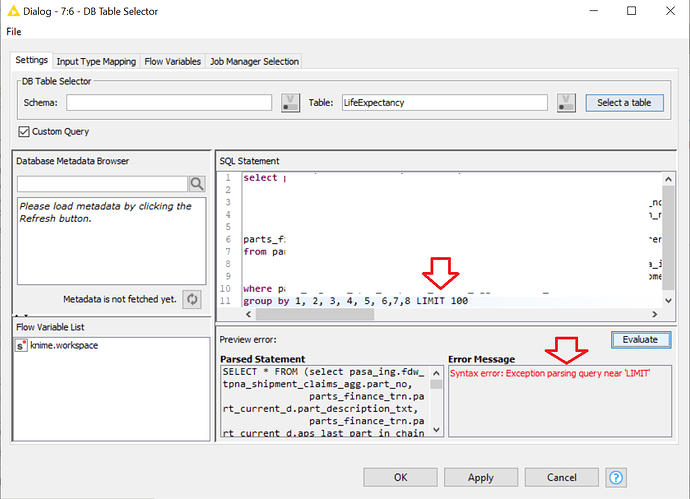Hi @pengchenhui , that seems like a rather poor implementation by Denodo and I would find that a very painful limitation as there are plenty of “real world” times outside of KNIME where I’ve wanted to limit the return in a sub query to just the first row it finds.
From KNIME’s perspective, I can see why it “wraps” queries in an outer select * from (... ). I’ve done similar myself when writing generic query builders outside of KNIME. It allows the whole process to retain control over the query that is being built inside, and can provide the ability to easily rename or cast the returned data columns without having to write a query-parser.
In terms of the use of the inner subquery when the “evaluate” button is pressed, the purpose there is to limit the returned query to just 10 rows. Placing the query inside a subquery and then limiting the returned rows on the outer query is a standard generic method that should work with just about any database. ( Although seemingly not Denodo in this instance  ).
).
Instead of using LIMIT or FETCH FIRST, I think Denodo can also limit rows using the “old fashioned” method of ROWNUM function. I used to have to do something similar with Oracle before they included the “fetch” clause.
If it’s anything like Oracle’s implementation, it’s not as good as the other methods in all circumstances especially if you are trying to return data using an ORDER BY clause, because unlike FETCH FIRST, ROWNUM is evaluated BEFORE ordering, whereas FETCH FIRST is evaluate AFTER ordering, but you could try using:
where rownum() < 100
e.g.
select * from table MYTABLE where rownum()<100
in your query and see if that works. (In Oracle we didn’t include the brackets, but I think brackets are required by Denodo)
If you need to return the first 100 rows, after some kind of ordering, ironically you might have to use a subquery yourself:
select * from
(select x,y,z from MYTABLE order by x)
where rownum() < 100
EDIT: I’ve just looked at some more Denodo documentation that says the rownum() function “can only be used in a select clause”, so you would unfortunately have to write this as
select * from
(select rownum() as rownum, x,y,z from MYTABLE ... etc)
where rownum < 100
A further alternative (which I think is horrible, but if all else fails, might be an option) is that to bring back a limited dataset in a specific instance you could write the query as a view, containing the fetch clause.
e.g.
create view my_limited_view as
select x,y,z from mytable fetch first 100 rows only
and then in KNIME you would use the query
select x,y,z from my_limited_view
It’s not something I’d recommend or want to do myself but it’s another approach if everything else fails.

